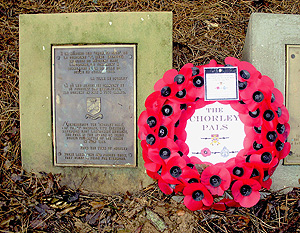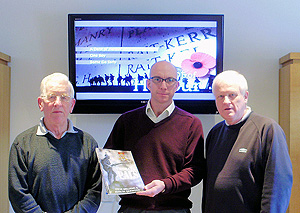The main reason for the trip to northern France in January 2010 was to visit the Commonwealth War Graves Commission facility near Arras, to view the work on the Chorley Pals Memorial plinth.
The eight Portland Limestone panels had been shipped from the UK a week earlier to their site at Beaurains, just south of Arras.

John with the hand grenade found in no-man’s land
Early in the morning of Wednesday 20th, I picked up fellow WW1 enthusiast & Chorley Pals Memorial Trustee, John Garwood, and we set off to Folkestone and the Channel Tunnel. Armed with two video cameras (one for personal / website use and one for Granada TV News), once in France we headed straight for the trenches on the Somme to lay a wreath at the Chorley Pals plaque at Serre. The temperature dropped as we headed up the track across No Man’s Land and it was hovering just above freezing as we laid the wreath of red poppies. Whilst looking around the site (known as Sheffield Memorial Park), John Garwood found an old hand grenade and wondered if it was dropped back in 1916 by Richard Barrow – a Chorley Pal and “Bomber” (John had met ‘Dickie’ Barrow on numerous occasions in the early-1980s). As we tried to do some filming, the weather set in and we retreated to the warmth of my car to watch the snow descend.

The wreath laid by Steve and John at the Chorley Pals plaque at Serre
Thursday morning saw us make our pre-arranged meeting with the staff at the Commonwealth War Graves Commission – we were warmly welcomed by Production Manager, Nigel Stevens. English and French staff started appearing, wanting to know all about our ‘private’ memorial – they normally engrave stone destined for Commonwealth cemeteries and memorials across Europe, and engrave up to 6,000 headstones a year from their site in Arras.
We were taken to the workshop to see the first panel of the memorial being engraved – coincidentally the front, with the Chorley Pals Memorial logo I had designed back in 2007. John and I paid particular attention to the engraving of the motto on the Chorley coat of arms. A number of Chorley residents had written to us and the local papers requesting we were historically correct – the ‘correct’ civic motto the Pals fought under in 1916 was “Beware”, but it was changed to “Be Aware” in 1988. We spent the morning at Beaurains and with the weather was improving, we decided to return to the Somme battlefield to do some filming.

The stone panels for the Chorley Pals statue in the yard at the Commonwealth War Grave Commission’s workshop in Arras
A quick visit to a cold (and deserted) Thiepval Memorial to the Missing of the Somme, saw us to pick out a few Chorley Pals photographs on the “Missing of the Somme” panel in the visitor centre nearby; on the panel I also found Private Samuel Hunt from my village of Brindle, who was killed on the 30th July 1916 whilst serving in the Liverpool Pals. At Serre I filmed the site and John did a piece about the Chorley Pals plaque he placed on a tree in the front-line trenches back in September 1985; the original wooden one mysteriously disappeared in 1997 and John replaced it with a metal one in 1998 (fortunately it is still there). John and I spent time paying respects to Chorley Pals buried in No Man’s Land in Queen’s Cemetery and Serre Road No. 3 Cemetery, before heading back to Beaurains to see another of ‘our’ panels being engraved.

Henry Calderbank’s name was the first to be engraved on the stone
At Beaurains we witnessed the front panel being removed from the engraving machine and the next panel being loaded. It was only then that John and I realised the true scale and weight of each of the eight panels that will make up the plinth (it took four men to manoeuvre it on to the fork lift truck!). We were then asked which name we wanted engraving first on the next panel – the machine could be programmed to start where it wanted and not at A. We both chose Private Henry Calderbank, as his youngest daughter – 93 year old Kathleen (Sister Francis) – would be the oldest surviving sibling of a Chorley Pal. Our choice brought a puzzled look from the French operator of the engraving machine but Nigel Stevens told him why – a few nods of appreciation and a warm smile needed no translation.

Steve and John present Nigel Stevens of the CWGC with the Chorley Pals book
Before we left, we thanked the staff at the War Graves Commission and presented Nigel Stevens with a signed copy of our book on the Chorley Pals, leaving an additional copy for the rest of the staff. With the knowledge of the job was in safe hands, we reluctantly left the offices at 6.00 p.m. leaving the machine to continue engraving the 225 Chorley Pals names onto the panels.
As we headed for home the following morning, John and I both confessed how privileged we had been to witness the engraving work. We wished we could have taken all the Pals relatives with us to see it, but at least we had some video footage to show them. We both looked forward to being ‘re-united’ with the panels back in Chorley at the unveiling in February.
Steve Williams
22.01.2010
Footnote: Our Chairman, Lindsay Hoyle MP and fellow Trustees wish to place on record our thanks and appreciation to all the staff of the Commonwealth War Graves Commission in Maidenhead and in Beaurains for all their work on the plinth; we hope to visit both offices in 2010 to thank them all personally. For more information on the Commonwealth War Graves Commission visit their website www.cwgc.org

